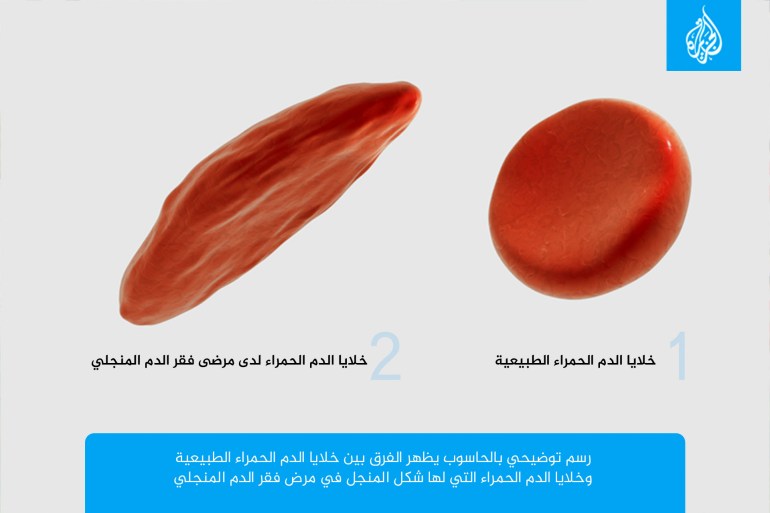Sickle cell disease is a group of inherited red blood cell disorders, with a problem with hemoglobin in the blood, according to Medline Plus of the National Library of Health in the United States of America.
Hemoglobin is a protein found in red blood cells that carries oxygen to all parts of the body. In sickle cell anemia, hemoglobin is formed in the form of stiff rods inside the red blood cells, and this changes the shape of the red blood cells. The cells are supposed to be disc-shaped, but this changes them to a crescent or sickle shape.
Sickle-shaped cells are not flexible and cannot change shape easily, and many of them burst as they move through blood vessels. Sickle cells usually live only 10 to 20 days, instead of the 90 to 120 days that normal red blood cells live.
Your body may have difficulty making enough new cells to replace the cells you lost. For this reason, you may not have enough red blood cells. This condition is called anemia, and it can make you feel tired.
Sickle cells can also stick to vessel walls, causing blockages that slow or stop blood flow. When this happens, oxygen cannot reach nearby tissues.
Lack of oxygen can cause bouts of severe and sudden pain (Crises). These attacks can occur without warning. If you have a seizure, you may need to go to the hospital for treatment.

What is the cause of sickle cell anemia?
Sickle cell disease is caused by a defective gene called the sickle cell gene. People with the disease are born with two sickle cell genes, one from each parent.
If you are born with one sickle cell gene, it is called sickle cell trait. People with sickle cell trait are generally healthy, but they can pass the defective gene to their children.
Symptoms of sickle cell disease?
People with sickle cell disease begin to show signs of the disease during the first year of life, usually at about 5 months of age.
Early symptoms of sickle cell anemia may include:
- Painful swelling of the hands and feet.
- Fatigue or discomfort.
- Yellowish skin color or yellowing of the whites of the eyes (jaundice).
The effects of sickle cell disease vary from one person to another, and can change over time, and most are related to complications of the disease, which may include:
- Severe pain.
- Anemia.
- Organ damage.
- Infections.
What are the treatments for sickle cell anemia?
The only treatment for sickle cell anemia is a bone marrow transplant or stem cell transplant, and because transplants can have serious side effects, they are usually only used in children with severe sickle cell anemia. For the transplant to be successful, the bone marrow must be a perfect match, and the best donor is usually a brother or sister.
There are treatments that can help relieve symptoms, reduce complications, and prolong life:
- Antibiotics to try to prevent infections in younger children.
- Analgesics for acute or chronic pain.
- “Hydroxyurea”, which is a medicine that has been proven to reduce or prevent many complications of sickle cell disease, and increases the amount of fetal hemoglobin in the blood. This medicine is not suitable for everyone.
- Blood transfusions to treat severe anemia.
ظهرت في الأصل على www.aljazeera.net

